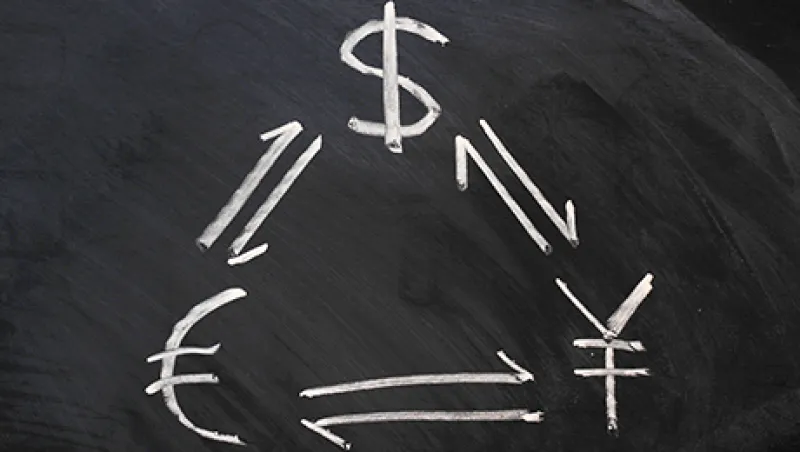Is it showtime again for the dollar? The currency’s powerful rally that sent it to multiyear highs against a range of its developed-markets peers early this year has stalled over the past five months. But market participants expect the greenback to climb anew as the Federal Reserve raises interest rates and other central banks remain in easing mode.
“I’m still a big dollar bull,” says Marc Chandler, global head of currency strategy at Brown Brothers Harriman in New York. “Policy divergence will keep the dollar underpinned.” He expects the Fed to increase rates once or twice in the next six months. The only other major central bank he sees doing so is the Bank of England, perhaps in the first half of next year.
Now that the Fed is finally set to raise rates, the greenback can rise in earnest. Most currency experts don’t expect the dollar to enjoy a huge rally, however, as the Fed has made clear it will move in very gradual fashion. The yuan’s devaluation represents something of a wild card, though market participants don’t expect it keep the dollar from gaining against other currencies.
As for monetary policy abroad, the European Central Bank is likely to continue purchasing €60 billion ($67 billion) a month of bonds through September 2016, and some analysts expect the Bank of Japan to increase its quantitative easing from the current pace of ¥80 trillion ($648 billion) a year. The subsequent monetary policy split reflects economic divergence that also will boost the dollar, market participants agree. Wells Fargo Securities sees U.S. growth coming in at 2.1 percent this year — not a stellar figure, but far above the bank’s forecast of 1.4 percent for the euro zone and 1.1 percent for Japan.
David Gilmore, a partner at currency analysis firm Foreign Exchange Analytics in Westbrook, Connecticut, says the euro could slip to $1.02 in the next six months and the dollar could reach ¥135, compared with Thursday’s rates of $1.1140 and ¥124.40, respectively. Although the market’s bullish consensus for the dollar is stronger than at any time since 1995, that hasn’t been enough to move it higher in recent months. “Fundamental factors make for a sound story of why the dollar should appreciate,” Gilmore says. “But you have to realize those factors may not determine where it goes.”
China’s decision to devalue the yuan Tuesday throws a bit of an unknown into the equation. “You can make the case now that China is joining the currency war,” says David Woo, head of global interest rates and currencies research at Bank of America Merrill Lynch in New York. He thinks the yuan will ultimately fall 10 percent from its predevaluation rate, putting the yuan at 6.90 to the dollar. The dollar traded at 6.3996 yuan Thursday. China’s economic and currency weakness will help make the Fed’s tightening cycle a short one, Woo says. But he doesn’t see this stopping the dollar from rising. “Our forecast for the next six months is that the dollar will go up, but in an increasingly disorderly global economic context.”
Europe is more exposed to China than the U.S., so China’s weakness won’t hurt the dollar against the euro, Woo says. Germany’s exports to China account for 3 percent of the country’s gross domestic product, compared with less than 1 percent for the U.S. Woo expects China to have little impact on dollar-yen. “Japan is exposed to China, so the yuan’s weakness isn’t good for the yen,” he said. “But if the Fed isn’t hiking aggressively, there is less reason for Japanese money to head out. That leaves the yen rangebound.”
China’s weakness should boost the dollar against other emerging-markets currencies, experts say. GDP expanded 7 percent in China during the second quarter, according to official data, conveniently matching the government’s target. Many economists believe that number is overstated, though.
China’s falling demand for commodities and the resulting decline in commodity prices are bad for the currencies of commodity producers in Latin America, such as Brazil and Colombia, and in East Asia, such as Indonesia and Malaysia. Emerging-markets currencies could fall to levels not seen since the Asian currency crisis of 1997–’98, Gilmore says. There may be bright spots, though: Asian economies running current-account surpluses such as the Philippines and South Korea may emerge largely unscathed from the dollar’s advance, says Eric Viloria, currency strategist at Wells Fargo Securities in New York.
Overall, the dollar is on a roll. Chandler thinks we’re in the midst of the dollar’s third long-term rally of the past 35 years. The first came in 1981–’85 under president Reagan, the second in 1995–2000 under president Clinton. And one began last year under President Barack Obama, Chandler says. He sees that move continuing through 2017, until policy convergence reemerges, by which time the euro will have dropped to 82 cents.
The dollar’s ascent might just outlast Obama’s tenure in the White House.
Get more on foreign exchange.







